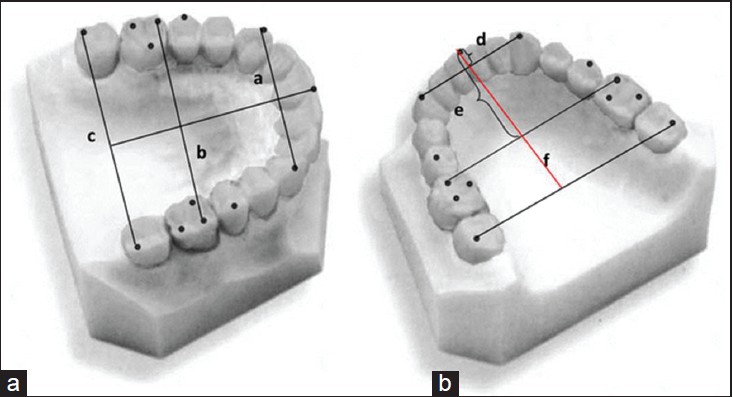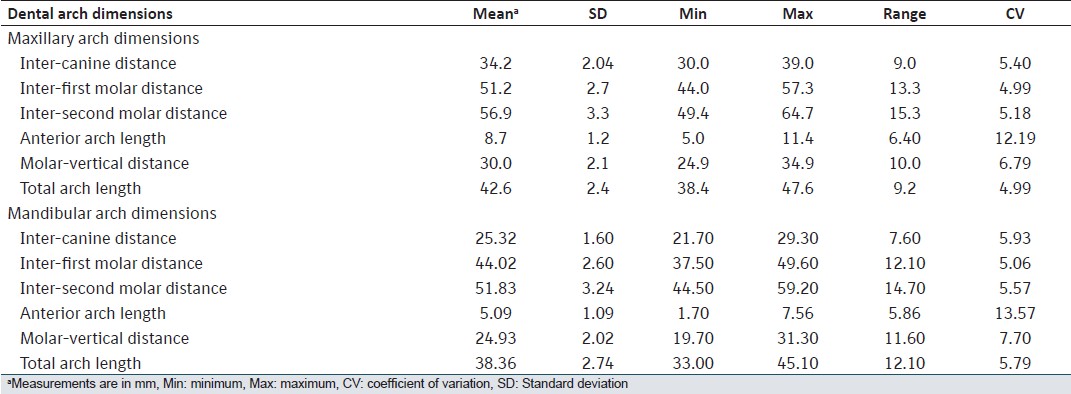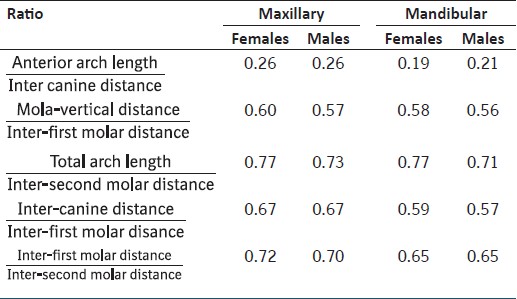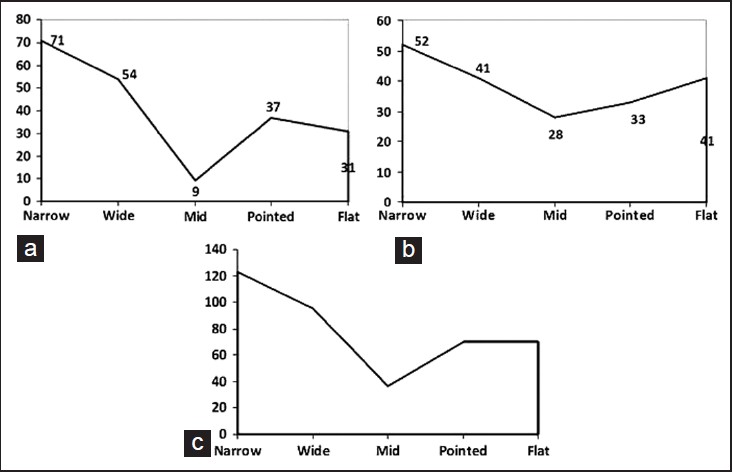|
 
 |
| ORIGINAL ARTICLE |
|
| Year : 2014 | Volume
: 2
| Issue : 2 | Page : 55-59 |
|
Determinants factors of Yemeni dental arch forms
Nabil Muhsen Al-Zubair
Department of Orthodontics, Faculty of Dentistry, Sana'a University, Sana'a, Yemen
| Date of Web Publication | 22-Apr-2014 |
Correspondence Address:
Nabil Muhsen Al-Zubair
Department of Orthodontics, Faculty of Dentistry, Sana'a University, Sana'a
Yemen
 Source of Support: None, Conflict of Interest: None  | Check |
DOI: 10.4103/2321-3825.131114

Introduction: This study was conducted to assess the determinants factors of the dental arch forms of Yemeni adult sample. Materials and Methods: The Eucledian clustering method of analysis was utilized for determination of the dental arch form, (398) study models were constructed and evaluated to do measurements for both arches using the modified sliding caliper gauge. A total of 6 dental cast measurements were divided into three sagittal measurements and three transverse measurements were utilized, which represent the dental arch widths and lengths measurements. Results: Narrow form is the most prevalent arch form 30.8% followed by wide form 24% their prominence appearance in females and the least prevalent arch form was the mid form 9.3%, whereas flat and pointed forms being in between 18.3% and 17.6 respectively. Conclusion: Five arch forms: Narrow, wide, mid, pointed and flat were distinguished as unique forms for the maxillary and the mandibular arches. It can be observed that the measurements related to the canine, have the widest range of reading and give the impression that the relation of canines to each other and to other teeth is the strongest factor in determining the dental arch form. Keywords: Arch form, arch form analysis, Yemeni dental Arch
How to cite this article:
Al-Zubair NM. Determinants factors of Yemeni dental arch forms. J Orthod Res 2014;2:55-9 |
| Introduction | |  |
The search for the elusive "ideal" arch form to suit every individual has been the focus of several reports. However, dental arch form and shape varies in individuals based on anatomic dimensions of the craniofacial skeleton. [1],[2] Qualitative description of the dental arch use terms such as elliptic, parabolic, U-shaped, or approximately catenary, whereas mathematical methods include several curve-fitting algorithms such as parabolas, semi ellipses, catenary's curves, conic section, cubic plane curve and second to eighth order polynomials. [3],[4]
Despite the huge efforts and research works done to determine the ideal arch form, there is a little agreement among investigators about the natural shape of the dental arches. [5],[6],[7]
Hawley, [8] based on the earlier work of Bonwill, [9] described the ideal arch as being constructed upon an equilateral triangle with slight modifications. The six anterior teeth were thought to be arranged on the arc of a circle whose radius was determined by the combined width of incisors and canines, with the premolars and first permanent molars arranged in a straight line and the second and third molars turning towards the midline.
Catenary arch design depends on inter-molar distance taken from central fossa to central fossa and it could be described as a central core around which the teeth arrange themselves. [10]
Brader [3] has proposed that the curve of the typical adult arch is best considered as a closed curve with the properties of a trifocal ellipse, with teeth occupying only the narrower end of the total curve.
Raberin et al. [11] in their study examined 278 dental casts of untreated French adults with normal occlusion. Six measurements of mandibular dental arch were performed and five independent ratios were determined. They developed an arch form guide and defined five mandibular dental arch forms (narrow, wide, mid, pointed and flat).
After all, it's worthy to be mentioned that determination of the dental arch form relies in the majority of the research-works upon dental arch width and length dimensions; [12] although some investigators choose to use some sophisticated mathematical equation for that purpose.
| Materials and Methods | |  |
Ethical approval was obtained from both the Ethics Committee of Sana'a University and the Faculty of Dentistry at the University of Sana'a. A brief outline of the study was explained to all participants and consent was obtained prior to participation.
The sample consists of 199 adults with aged ranges between 18 and 26 years, among whom 97 were males and 102 females, selected from clinical examination of 1703 Yemeni adults, comprised of 827 males and 876 females.
The following criteria were used for sample selection: (1) Full complement of the permanent dentition (excluding third molars); (2) class I molar occlusion and class I canine occlusion; (3) class I skeletal relationship, decided visually by using the two-finger technique; (4) free of local factors that disturb the integrity of the dental arches (congenital missing teeth; retained deciduous; supernumerary teeth); (5) normal vertical and horizontal dental relationships (normal overjet and normal overbite); (6) no heavy fillings that may affect the dental arch size and form; (7) no previous orthodontic, orthopedic, or facial surgical treatments; (8) well-aligned arches with less than 2 mm of spacing or crowding in either arch.
Measurements were taken from 398 maxillary and mandibular dental casts, which were made of dental stone, with the base, made of plaster of Paris. The base was trimmed according to the way used in orthodontics and numbered corresponding to the number given to the subjects. Dental arch dimensions measurements were carried out using the modified sliding calipers gauge which is accurate up to 0.02 mm.
Dental Arch Widths and Lengths
Six dental cast measurements were divided into three sagittal measurements, and three transverse measurements were utilized, which represent the dental arch widths and lengths measurements [Figure 1]. | Figure 1: Dental Arch Dimensions; (a) Arch width; a: inter-canine distance; b: inter-first molar distance; c: inter-second molar distance; (b) Arch length; d: anterior arch length; e: molar-vertical distance; f: total arch length
Click here to view |
Dental Arch Forms
For determination of the dental arch form, the method used by Raberin et al. [11] was utilized, which depends on the Eucledian clustering method of analysis. Six dental cast measurements were divided into three: Sagittal measurements, and three transverse measurements were utilized to calculate five independent ratios, which are (anterior arch length/inter-canine distance; molar-vertical distance/inter-first molar distance, total arch length/inter-second molar distance, inter-canine distance/inter-first molar distance, molar-vertical distance/total arch length). Eucledian distance between the five ratios of each subject with the different centroid of clusters was calculated, each subject was allocated according to the nearest centriod and as a result five arch forms were developed for the maxillary arch.
Statistical Analysis
All statistical analyses were performed using SPSS 13.0 software (Statistical Package for the Social Science, IBM Corporation, New York, NY). Descriptive statistics were performed for the calculation for the mean, standard deviation and coefficient of variance for the dental arch dimensions. Eucledian clustering analysis was used to identify the dental arch forms. Statistical significance was pre decided at the 95% level (P < 0.05).
| Results | |  |
The means and standard deviations (M ± SD) of the maxillary and mandibular dimensions are shown in [Table 1]. The minimum and maximum values were recorded and expressed by the range. It can be noticed that the inter-second molar distances have the widest range. | Table 1: Descriptive statistics for dental arch dimensions for the total sample
Click here to view |
The range of reading is expressed by the coefficient of variation (CV) values. They reflect the different arch size and form. The inter-canine distance and anterior arch length showed the highest values of CV in both maxillary and mandibular dental arches, whereas the others related dimensions were close to each other [Table 1].
The correlation coefficient was carried out between arch widths and lengths, some of them showed high significant, positive and direct relations, other showed moderate, weak or negative relationships. The correlations were clearly prominent and stronger between inter-canine distance and anterior arch length with other arch dimensions especially in female group as shown in [Table 2].
[Table 3] shows the average of the five ratios used in the determination of the dental arch forms. The percentage of relative deviation between the mean value of a given ratio for arch form and the mean value of the same ratio for the whole sample helped us to see how each of the five forms distinguished itself from the average form. | Table 3: Mean values for the five ratios used in the determination the arch form
Click here to view |
Five arch forms were distinguished (narrow, wide, mid, pointed and flat). The distribution of subjects according to these five forms [Figure 2] is more or less balanced with a frequency of each group varying between 9.3% and 30.8% showing predominance of narrow arch form and fewer tendencies for mid arch form. The narrow form (30.8%) is the most frequent arch form followed by wide arch form (24%), whereas mid form (9.3%) is the least frequent in both gender. Pointed and flat arch forms are relatively equally distributed. Narrow arch form is somewhat more common in females. | Figure 2: Distribution of the five dental arch forms. (a) Female; (b) male; (c) total sample
Click here to view |
| Discussion | |  |
The inter-canine distance was selected because it was stable in the maxillary and mandibular arches after 13 years of age and the studies of retention and relapse stressed on the need of stable unchangeable inter-canine width. [13] At the same time, the inter-canine width with the anterior arch length will accurately describe the arch form anteriorly (pointed or flat).
The inter-first molar distance gives full picture about the widths of the arch, enabling to distinguish between narrow and wide arches especially when using the inter-canine distance/inter-first molar distance ratio.
The inter-second molar distance was not given the same concern as the inter-first molar distance in previous studies as they assumed that the arch width distal to the first molar was similar to that of inter-first molar width and was not an area of importance as most of our orthodontic appliances were dealing with the arch mesial to the second molar without incorporating it in most of our treatment plans. However we should not forget that we are dealing with a full complement of permanent teeth, even the third molar. Furthermore many studies that were performed on commercially produced ready-formed wires concluded that almost all of these wires tend to narrow or being unchangeable distal to the first molar while the dental arch tended to widen posteriorly and hence the second molar width was taken into consideration in the present study. It is worth mentioning that the largest difference between males and females exists in the inter-second molar distance in both dental arches, which may be attributed to the difference in arch form. To complete the skeleton of the arch form four arch length dimensions selected including: Anterior, molar-vertical distance and total arch length.
In general, it was obvious that the mean values of all measurements taken for the dental arch dimensions confirmed the accepted view that the maxillary dental arch was larger in all dimensions than that in the mandibular counterpart. [14],[15],[16]
Since Angle, [17] orthodontists have tried to determine a single, ideal arch form that can ensure the stability of the therapeutic results. The findings of the present study confirm that the ideal dental arch form has not a single and universal form, but that there are five different forms in untreated adults with normal occlusion.
Form (1); narrow: This arch form is characterized by higher values of the sagittal/transverse ratios when compared with the mean values for these ratios, which indicates relative increase in arch lengths when compared with arch widths.
Form (2); wide: This arch form is characterized by lower values of the sagittal/transverse ratios when compared with the mean values for those ratios, which indicates relative increase in arch widths when compared with arch lengths.
Form (3); mid: This arch form is characterized by non-significantly deviated values of the sagittal/transverse ratios when compared with the mean values, and this means that the values of sagittal and transverse measurements have one of three possibilities:
Both the sagittal and transverse values centered on the corresponding mean values of the measurements of the whole sample.
The sagittal measurements have high values which are neutralized by high values of transverse measurements.
The sagittal measurements have low values, which are again neutralized by, low values of transverse measurements.
Form (4); pointed: This arch form is characterized by a noticeably high values of anterior arch length/inter-canine distance ratio, which indicates relative increase of anterior arch length and relative decrease in the inter-canine distance.
Form (5); flat: This form is opposite to the pointed form and characterized by a noticeably low value of anterior arch length/inter-canine distance ratio, which indicates relative decrease of anterior arch length and relative increase in the inter-canine distance.
Determinants Factors of Yemeni Dental Arch Forms
According to Proffit [15] dental arch form consists of dental units arranged in unique positions along a compound curve which represents a steady state of equilibrium delimited by the counter balancing force fields of the tongue and of the circumoral tissues.
Studying the descriptive analysis for the dental arch width revealed that the CV values for all measurements are nearly close to each other, with the inter-canine distances showing the higher CV than the others. The inter-canine distance is responsible for the different arch forms.
It can be also noticed from the descriptive analysis of the dental arch length that the CV values for all measurements are nearly close to each other, with the anterior arch length showing the highest CV value.
The anterior arch length values share the inter-canine distance values through the ratio in the contribution of determining all types of the dental arch forms and it is the most important ratio that determines the five dental arch forms. Hence, it is not unexpected for the anterior arch length to have the highest CV among other dimensions. These results are in full agreement with conclusions of Andria and Carlos. [18]
In general, it can be observed that the measurements related to the canine, have the widest range of reading and give the impression that the relation of canines to each other and to other teeth is the strongest factor in determining the dental arch form.
Establishment of the most frequent dental arch form is useful in both diagnosis and construction or choosing the ready-made arch wires.
The predominance of the narrow type in both maxillary and mandibular dental arches in the present study is not in agreement with the findings of Patel et al., [19] who found that the most frequent maxillary form is the mid form and Burris and Harris [20] who found that the most frequent mandibular arch form squarer in American blacks in the canine-premolar region, while data collected by Felton and Sinclair [2] revealed a predominance of the narrowest mandibular arch form.
| Conclusion | |  |
The arch form could possibly be clustered and used to describe each form of the maxillary and the mandibular arches. Five arch forms: Narrow, wide, mid, pointed and flat were distinguished as unique forms for the maxillary and the mandibular arches. In the present sample of Yemeni adult, the most prevalent form is the narrow form in both males and females.
| References | |  |
| 1. | Musich DR, Ackerman JL. The catenometer: A reliable device for estimating dental arch perimeter. Am J Orthod 1973;63:366-75. 
[PUBMED] |
| 2. | Felton JM, Sinclair PM, Jones DL, Alexander RG. A computerized analysis of the shape and stability of mandibular arch form. Am J Orthod Dentofacial Orthop 1987;92:478-83. 
|
| 3. | Brader AC. Dental arch form related with intraoral forces: PR=C. Am J Orthod 1972;61:541-61. 
[PUBMED] |
| 4. | Ferrario VF, Sforza C, Miani A Jr, Tartaglia G. Mathematical definition of the shape of dental arches in human permanent healthy dentitions. Eur J Orthod 1994;16:287-94. 
|
| 5. | Currier JH. A computerized geometric analysis of human dental arch form. Am J Orthod 1969;56:164-79. 
[PUBMED] |
| 6. | White LW. Individualized ideal arches. J Clin Orthod 1978;12:779-87. 
[PUBMED] |
| 7. | Rudge SJ. A computer program for the analysis of study models. Eur J Orthod 1982;4:269-73. 
[PUBMED] |
| 8. | Hawley CA. Determination of the normal arch, and its application to orthodontia. Dent Cosm 1905;38:541-52. 
|
| 9. | Bonwill WG. Geometrical and mechanical laws of articulation. Transactions of the Odontological society of Pennsylvania 1885;119:133. 
|
| 10. | Lavelle CL. A metrical study of dental arch form. J Dent 1978;6:120-4. 
[PUBMED] |
| 11. | Raberin M, Laumon B, Martin JL, Brunner F. Dimensions and form of dental arches in subjects with normal occlusions. Am J Orthod Dentofacial Orthop 1993;104:67-72. 
|
| 12. | BeGole EA, Fox DL, Sadowsky C. Analysis of change in arch form with premolar expansion. Am J Orthod Dentofacial Orthop 1998;113:307-15. 
|
| 13. | Bishara SE, Jakobsen JR, Treder J, Nowak A. Arch width changes from 6 weeks to 45 years of age. Am J Orthod Dentofacial Orthop 1997;111:401-9. 
|
| 14. | Sillman JH. Dimensional changes of dental arches: Longitudinal study from birth to 25 years. Am J Orthod 1964;50:824-42. 
|
| 15. | Proffit WR. Etiology of Malocclusion, Contemporary Orthodontics. 4 th ed. St. Louis: Mosby; 2007. p. 145-9. 
|
| 16. | Eid A, El-Namrawy M, Kadry W. The relationship between the width, depth and circumference of the dental arch for a group of Egyptian school children. Egypt Orthod J 1987;1:113-36. 
|
| 17. | Angle EH. Treatment of Malocclusion of the Teeth. 7 th ed. Philadelphia, S.S: W. B. Saunders Company; 1907. 
|
| 18. | Andria LM, Dias JC. Relation of maxillary and mandibular intercuspid width to bizygomatic and bigonial breaths. Angle Orthod 1978;48:154-62. 
[PUBMED] |
| 19. | Patel VJ, Bhatia AF, Mahadevia SM, Italia S, Vaghamsi M. Dental arch form analysis in Gujarati males and females having normal occlusion. J Indian Orthod Soc 2012;46:295-9. 
|
| 20. | Burris BG, Harris EF. Maxillary arch size and shape in American blacks and whites. Angle Orthod 2000;70:297-302. 
|
[Figure 1], [Figure 2]
[Table 1], [Table 2], [Table 3]
|